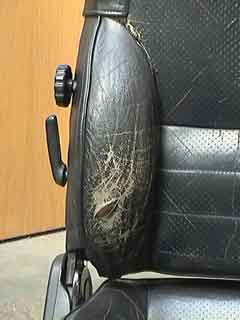How To Fix Car Seat Rip Like A Pro
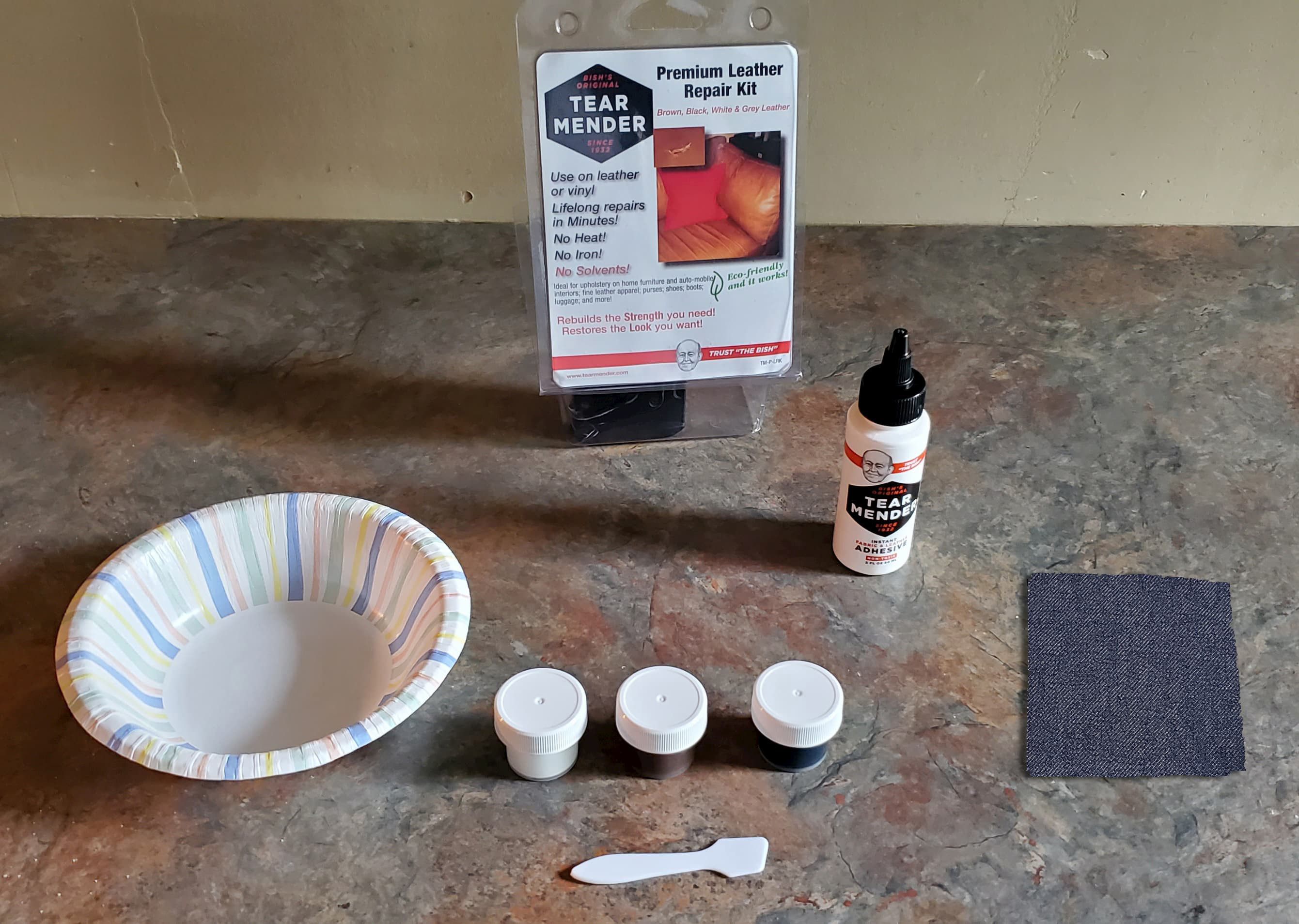
Fixing a car seat rip is achievable with the right techniques and materials, and CARDIAGTECH.NET is here to guide you. Whether it’s a seam tear or surface damage, our comprehensive guide provides effective solutions. Repairing your car seat enhances its appearance and prevents further damage, saving you money on replacements. Let’s explore easy car seat repair, leather repair solutions, and vinyl seat repair, all while keeping your car’s interior looking its best.
1. Understanding Car Seat Rip Types
Before you start the repair, understanding the type of rip is essential. Here are the common types:
- Seam Tears: Occur along the stitched seams.
- Surface Tears: Affect the leather or vinyl surface.
- Holes: Complete punctures through the material.
- Cracks: Small lines on the surface that can spread.
Identifying the rip type helps you choose the right repair method and materials, ensuring a lasting fix.
2. Essential Tools and Materials for Car Seat Repair
Having the right tools and materials ensures your repair is professional and durable. Here’s a list of essentials:
| Tool/Material | Description | Usage |
|---|---|---|
| Leather Repair Kit | Includes adhesive, color compounds, and patch fabric. | Fixing leather tears and matching the seat’s color. |
| Vinyl Repair Kit | Contains vinyl adhesive, grain paper, and color compounds. | Repairing vinyl tears and restoring the original texture. |
| Heavy-Duty Thread | Strong thread for sewing seams. | Reinforcing stitched areas and preventing future tears. |
| Curved Upholstery Needle | Designed for sewing through thick materials. | Makes sewing easier and more precise in tight spaces. |
| Scissors or Utility Knife | For cutting fabric and trimming excess material. | Ensures clean cuts and precise application of patches. |
| Cleaning Supplies | Leather cleaner or vinyl cleaner and a soft cloth. | Prepares the surface for repair by removing dirt and oils, ensuring better adhesion. |
| Sandpaper | Fine-grit sandpaper for smoothing rough edges. | Creates a smooth surface for the adhesive to bond, resulting in a seamless repair. |
| Alcohol Wipes | For cleaning the repair area before applying color compounds. | Removes any remaining residue, ensuring the color compound adheres properly. |
| Heat Gun | Used to cure vinyl repair compounds (for vinyl seats). | Accelerates the drying process and ensures a strong bond, making the repair more durable. |
| Patch Material | Denim, leather, or vinyl patch for backing tears. | Provides support and reinforcement behind the tear, preventing it from spreading. |
| Color Compounds | Various shades of color to match the original seat color. | Blends the repair seamlessly with the surrounding material, making it virtually invisible. |
| Spatula or Applicator | For applying color compounds smoothly. | Ensures even application and a professional finish. |
| Protective Gloves | Protects hands from adhesives and chemicals. | Keeps your hands clean and safe while working with various repair materials. |
| Masking Tape | For protecting surrounding areas from adhesive or color compounds. | Prevents accidental staining or damage to other parts of the seat. |
| Seam Ripper | Useful for removing old or damaged stitching. | Helps to prepare the area for repair by removing any obstructive threads. |
| Upholstery Clips | Holds fabric together while adhesive dries. | Keeps the patch securely in place, ensuring a strong and lasting bond. |
| Magnifying Glass | Useful for inspecting small tears and cracks. | Helps to identify the extent of the damage and ensure thorough repair. |
| Lighting | Good lighting to see the repair area clearly. | Ensures you can see all the details and perform the repair accurately. |
| Safety Glasses | Protects eyes from debris and chemicals. | Keeps your eyes safe while sanding, cutting, and applying adhesives. |
| Respirator Mask | Protects from fumes when using certain adhesives or chemicals. | Ensures you are protected from harmful vapors, especially in enclosed spaces. |
| Ruler or Measuring Tape | For measuring patch sizes and ensuring accurate cuts. | Helps to create a precise and professional repair. |
| Paper Towels | For cleaning spills and wiping excess material. | Keeps your workspace clean and ensures a tidy repair. |
| Bucket or Container | For mixing color compounds. | Provides a clean and convenient space for mixing the colors to match your seat perfectly. |
| Stir Sticks | For mixing color compounds thoroughly. | Ensures the color compounds are evenly mixed, resulting in a consistent and professional finish. |
| Clamps | For holding patches in place during the drying process. | Keeps the patch securely bonded while the adhesive cures, ensuring a strong and lasting repair. |
| Heat-Resistant Mat | For protecting surfaces when using a heat gun. | Prevents damage to surrounding areas when applying heat to vinyl repairs. |
| Detail Brushes | For precise application of color compounds in small areas. | Ensures accurate and detailed coloring, making the repair virtually undetectable. |
| Texture Pads | Used to replicate the texture of the seat material. | Helps to blend the repair seamlessly with the original texture, providing a professional and uniform appearance. |
| Fillers | For filling deep tears or holes before applying color compounds. | Creates a smooth and even surface for the color compounds, resulting in a durable and aesthetically pleasing repair. |
| Fabric Protectors | Applied after repair to protect against future damage. | Helps to prolong the life of the repair and protects the seat material from stains, fading, and wear. |
| Leather Conditioner | For maintaining the leather and preventing future cracks (for leather seats). | Keeps the leather supple and prevents it from drying out and cracking, ensuring long-lasting durability and a luxurious appearance. |
Having these tools and materials on hand will make the car seat repair process smoother and more effective. At CARDIAGTECH.NET, we offer expert advice on selecting the best tools for your specific needs. Contact us at +1 (641) 206-8880 for personalized recommendations.
3. How to Fix a Seam Tear in a Car Seat
Seam tears are common and relatively straightforward to fix. Here’s a step-by-step guide:
- Prepare the Area:
- Clean the area around the tear with a leather or vinyl cleaner to remove dirt and oils.
- Use a seam ripper to remove any loose threads around the tear.
- Cut a Patch:
- Cut a piece of denim, leather, or vinyl patch larger than the torn area. The patch should extend at least an inch beyond the tear on all sides.
- Round the corners of the patch to prevent them from catching.
 The Leather Repair Kit Comes With Tear Mender Adhesive, Color Compounds And Patch Fabric
The Leather Repair Kit Comes With Tear Mender Adhesive, Color Compounds And Patch Fabric
- Insert the Patch:
- Insert the patch into the hole, centering it under the torn area.
- Ensure the patch is smooth and covers the entire tear.
 Place The Repair Patch Inside The Rip
Place The Repair Patch Inside The Rip
- Apply Adhesive:
- Dispense Tear Mender or a similar adhesive into a paper bowl.
- Dip your finger or a small applicator into the adhesive.
- Apply a thin layer of adhesive to the patch while holding the tear open.
- Be careful not to apply too much adhesive, especially if the car seat has perforated holes.
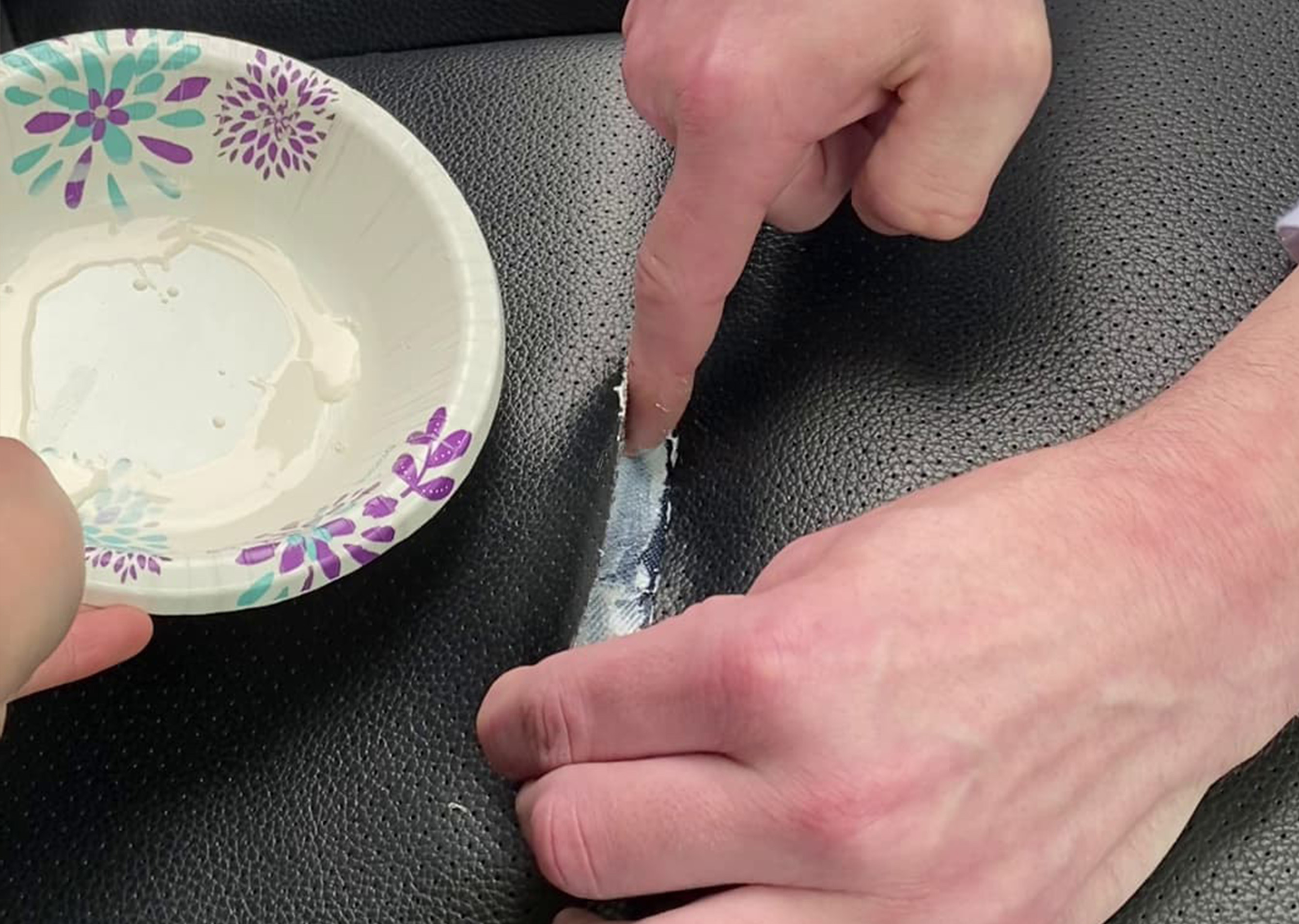 Use Your Finger To Apply A Thin Layer Of Tear Mender
Use Your Finger To Apply A Thin Layer Of Tear Mender
- Press and Dry:
- Press the leather or vinyl down onto the patch.
- Hold it in place for about 3 minutes to allow the adhesive to set.
- Use upholstery clips or clamps to keep the patch secure while it dries completely (usually a few hours).
 The Torn Leather Seat Has Been Repaired with Tear Mender
The Torn Leather Seat Has Been Repaired with Tear Mender
- Stitch the Seam (Optional):
- If desired, use a curved upholstery needle and heavy-duty thread to stitch the seam back together.
- Follow the original stitch pattern to maintain the seat’s appearance.
- This step adds extra strength and durability to the repair.
- Trim Excess Material:
- Once the adhesive is fully dry, trim any excess patch material with scissors or a utility knife.
- Be careful not to cut the car seat material.
- Clean the Area:
- Wipe the repaired area with a clean, damp cloth to remove any adhesive residue.
- Allow the area to dry completely before using the seat.
For optimal results, CARDIAGTECH.NET recommends using high-quality adhesives and patches. Contact our experts at +1 (641) 206-8880 for advice on the best products for your car seat repair.
4. Repairing Surface Damage and Cracks on Leather Car Seats
Surface damage and cracks require a different approach than seam tears. Here’s how to fix them:
- Clean the Area:
- Use a leather cleaner to thoroughly clean the damaged area.
- Remove any dirt, oils, or debris from the cracks.
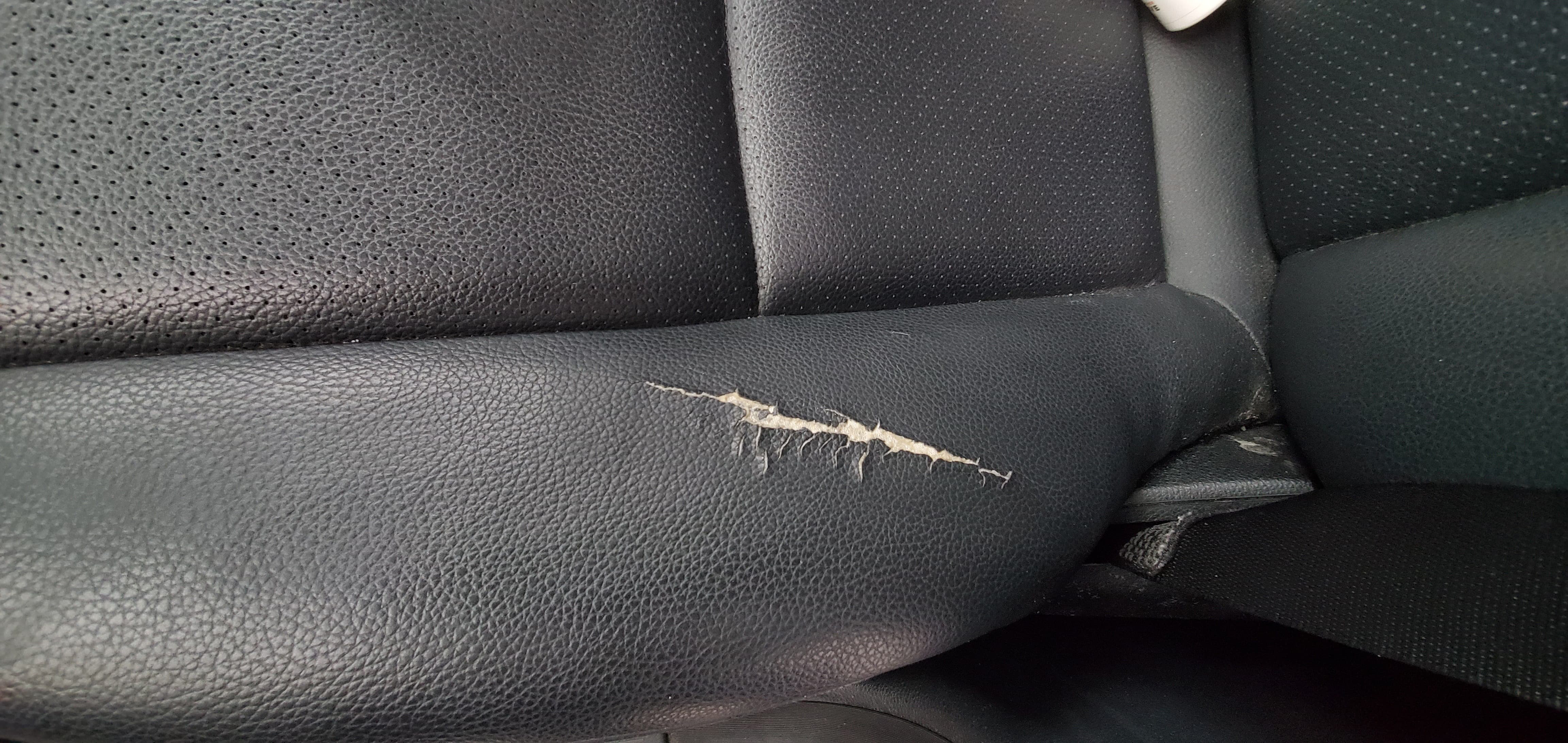 Cracked Leather on Car Seat
Cracked Leather on Car Seat
- Apply Tear Mender:
- Dispense Tear Mender into a disposable bowl or cup.
- Dip your finger in the Tear Mender and use it to fill in the low points of the cracks and surface tears.
- Allow to dry.
 Dispense Tear Mender Into A Bowl
Dispense Tear Mender Into A Bowl
 Using Your Finger Apply Tear Mender Into The Cracked Leather
Using Your Finger Apply Tear Mender Into The Cracked Leather
- Repeat Application:
- Depending on the depth of the damage, repeat the Tear Mender application to completely fill in the cracks.
- This may require several layers, allowing each layer to dry before applying the next.
- Sand the Area:
- Use an emery board (a disposable nail file) to sand away the excess fabric glue.
- Remove the shiny finish in the area immediately surrounding the damage.
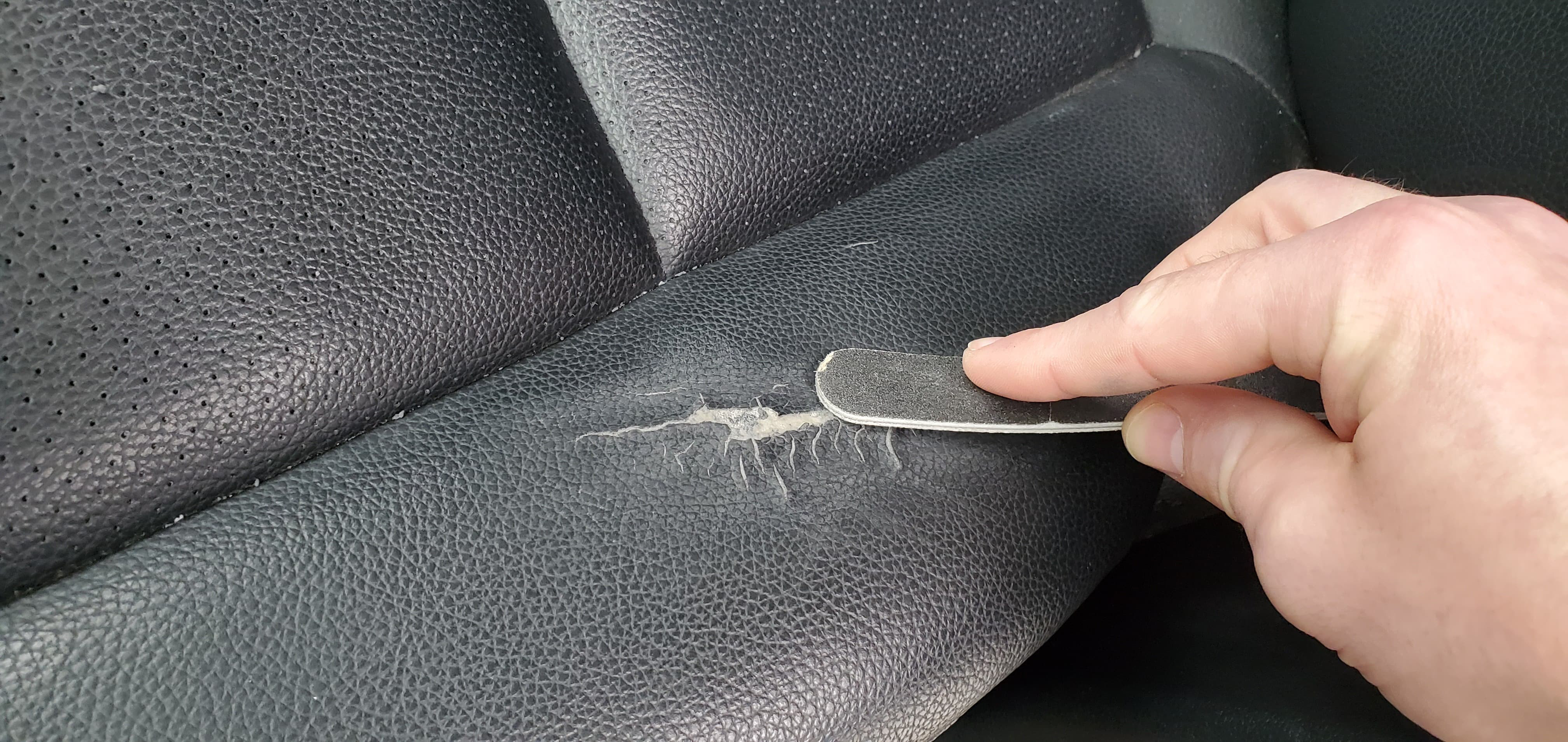 Use An Eemory Board To Smooth The Surface Of The Tear
Use An Eemory Board To Smooth The Surface Of The Tear
- Clean with Alcohol:
- Wipe the area with an alcohol pad to ensure the finishing compound will adhere to the surface.
 Use An Alcohol Wipe To Clean And Prepare The Tear For Color Compound Application
Use An Alcohol Wipe To Clean And Prepare The Tear For Color Compound Application
- Mix Color Compound:
- Mix a combination of the finishing compounds (white, black, and brown) to match the color of your car seat.
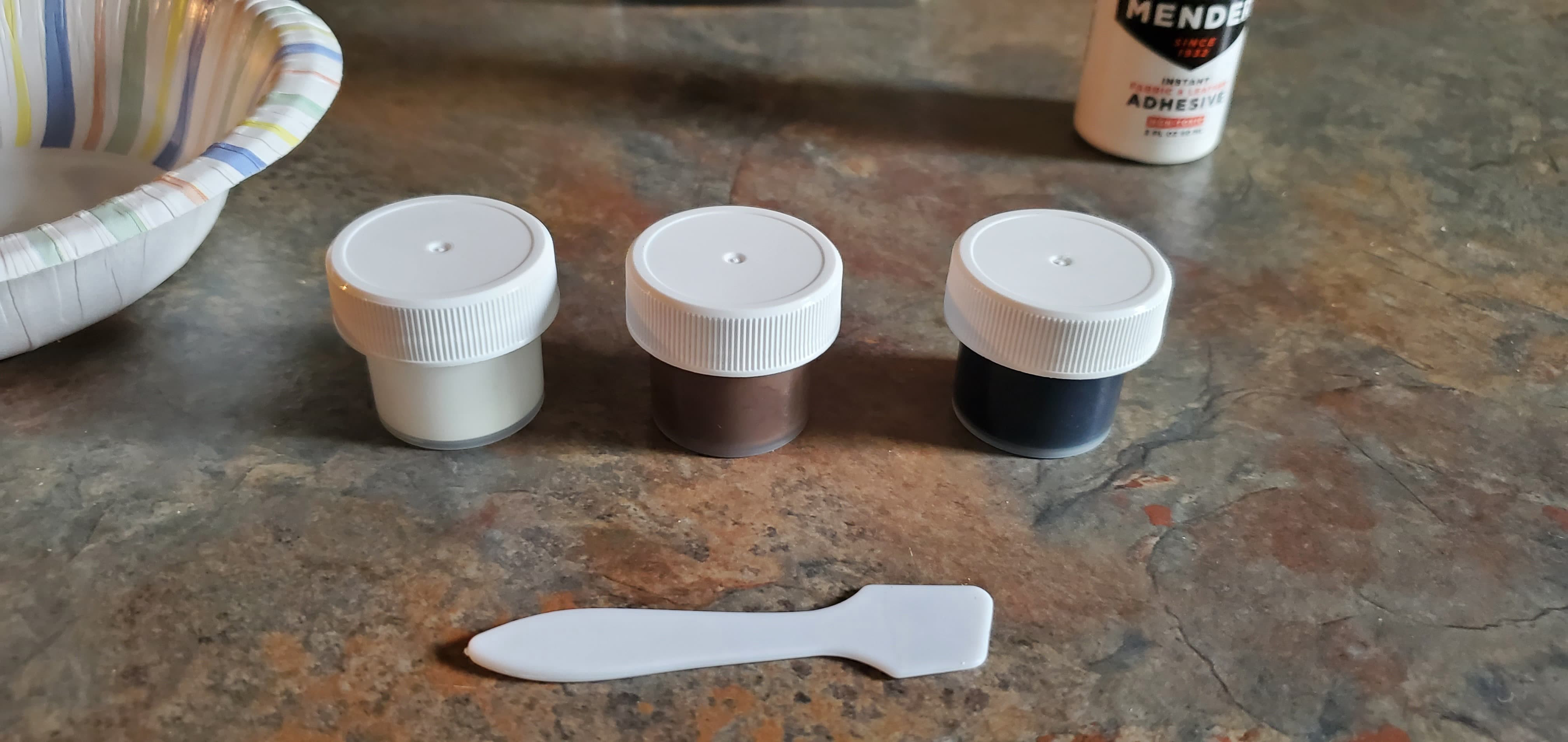 The Leather Repair Kit Comes With Three Shades of Color Compound
The Leather Repair Kit Comes With Three Shades of Color Compound
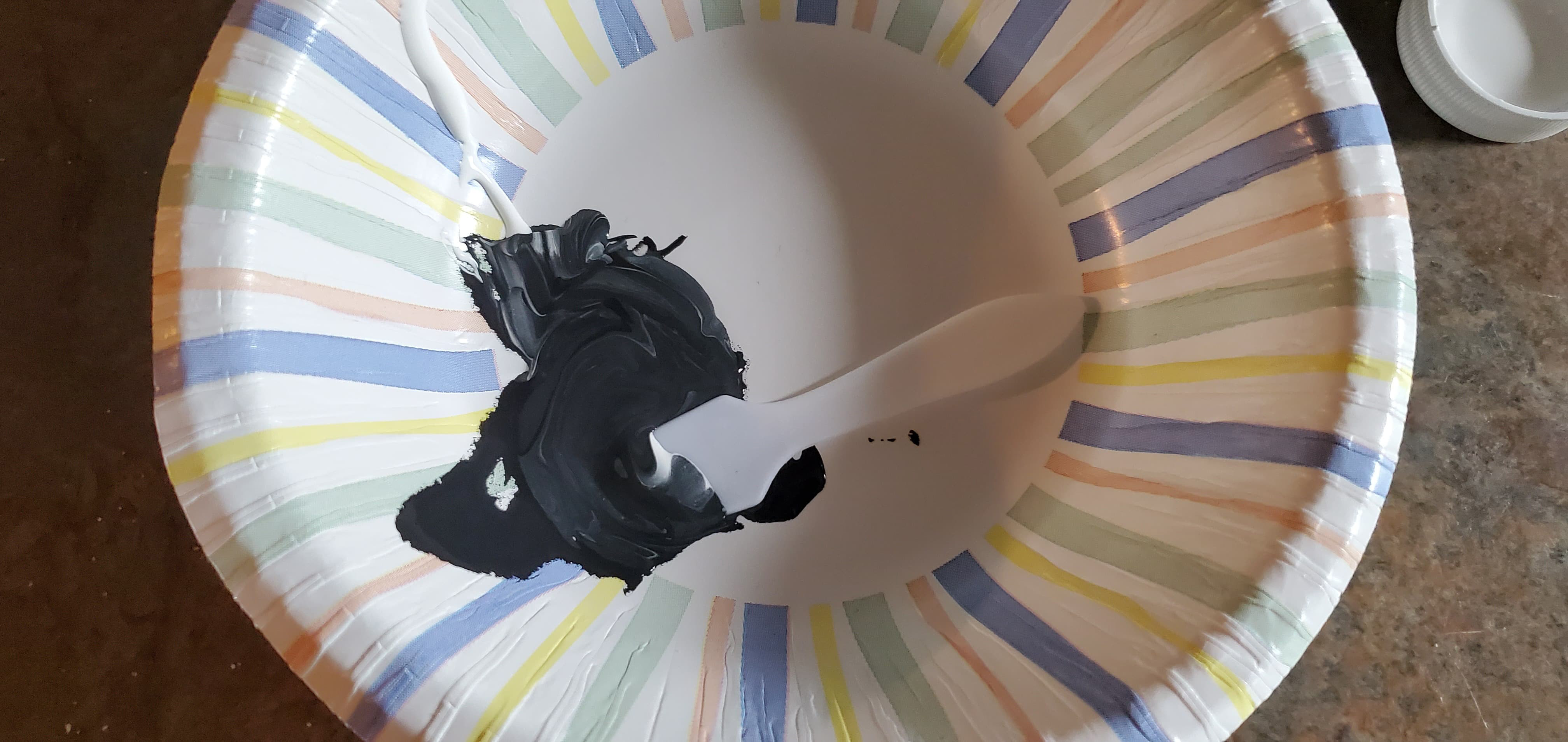 Mix The Colors Together Until You Reach A Match For Your Leather
Mix The Colors Together Until You Reach A Match For Your Leather
- Apply Finishing Compound:
- Apply a thin layer of the finishing compound with a plastic spatula.
- Let it dry completely.
 Apply A Layer of Finishing Compound Over The Repair
Apply A Layer of Finishing Compound Over The Repair
- Repeat Application:
- Repeat the application of the finishing compound until the repair is obscured.
- Gently blot the final coat with a sponge to add texture and match the surrounding leather.
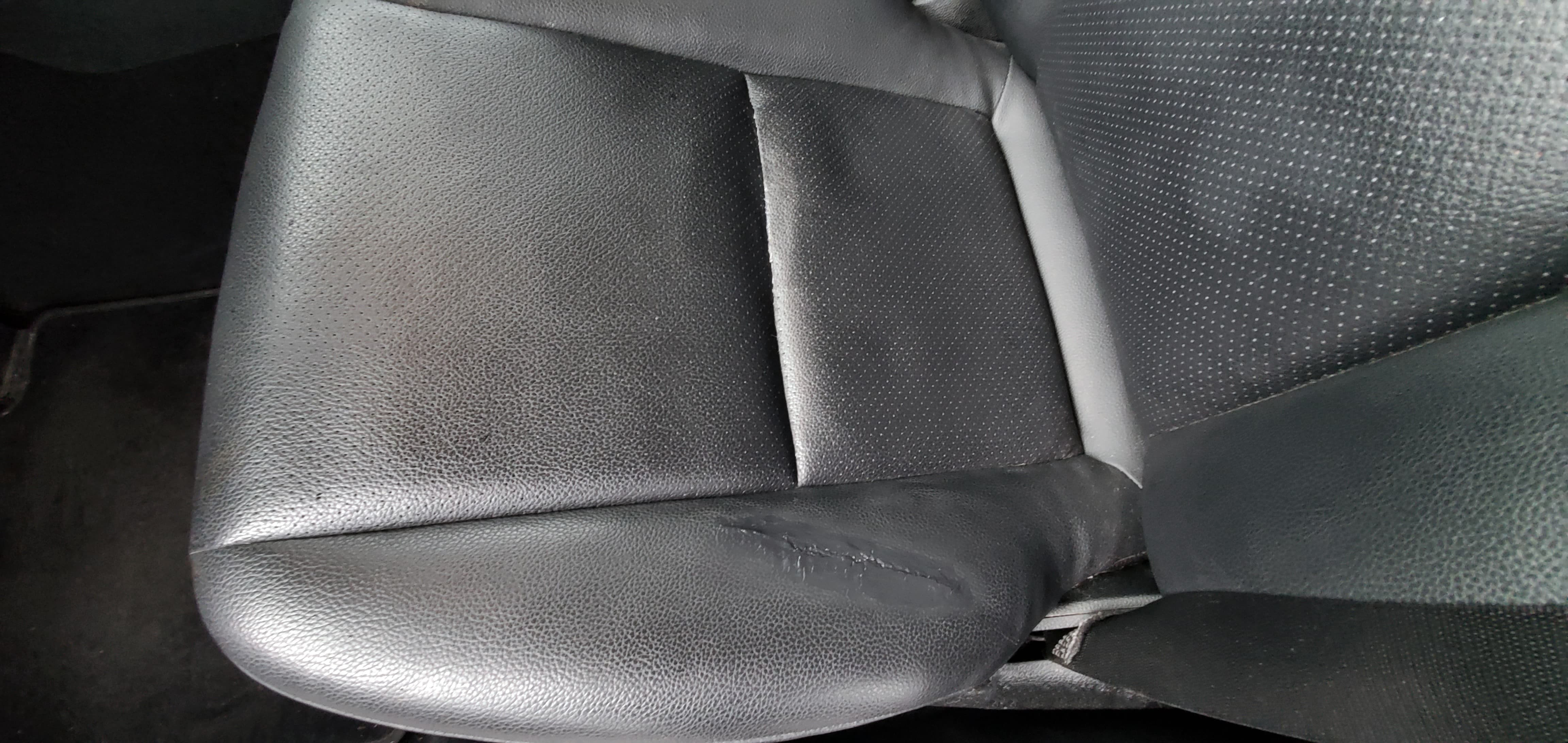 The Torn Seat Has Been Repaired With Tear Mender And Disguised By Color Compound
The Torn Seat Has Been Repaired With Tear Mender And Disguised By Color Compound
For a seamless finish, CARDIAGTECH.NET recommends taking your time and applying thin layers of the finishing compound. If you need help matching the color of your car seat, contact our experts at +1 (641) 206-8880 for assistance.
5. Step-by-Step Guide to Repairing Vinyl Car Seats
Vinyl car seats require a slightly different approach compared to leather. Here’s a detailed guide:
- Clean the Area:
- Clean the damaged area with a vinyl cleaner and a soft cloth.
- Remove any dirt, oils, or debris.
- Prepare the Patch:
- Cut a vinyl patch slightly larger than the tear.
- Round the corners of the patch.
- Apply Vinyl Adhesive:
- Apply a thin layer of vinyl adhesive to both the patch and the damaged area.
- Allow the adhesive to become tacky (usually a few minutes).
- Apply the Patch:
- Carefully apply the patch over the tear, ensuring it is smooth and covers the entire damaged area.
- Press firmly to ensure a strong bond.
- Apply Heat (If Required):
- Some vinyl repair kits require heat to cure the adhesive. Use a heat gun according to the kit instructions.
- Be careful not to overheat the vinyl, which can cause damage.
- Apply Color Compound:
- Mix the color compounds to match the color of your vinyl seat.
- Apply the color compound to the patch in thin layers, allowing each layer to dry before applying the next.
- Texture the Repair:
- Use grain paper or a texture pad to replicate the texture of the vinyl seat.
- Press the texture pad onto the wet color compound and allow it to dry.
- Clean the Area:
- Once the repair is complete, clean the area with a vinyl cleaner and a soft cloth.
CARDIAGTECH.NET provides a range of high-quality vinyl repair kits to ensure a professional finish. Contact us at +1 (641) 206-8880 for more information and to find the perfect kit for your needs.
6. Preventing Future Car Seat Damage
Prevention is key to maintaining your car seats. Here are some tips to prevent future damage:
- Regular Cleaning:
- Clean your car seats regularly with appropriate cleaners.
- This prevents dirt and oils from building up and causing damage.
- Use Seat Covers:
- Consider using seat covers to protect your seats from wear and tear.
- Seat covers are especially useful if you have pets or children.
- Avoid Sharp Objects:
- Be careful when carrying sharp objects in your car.
- Avoid placing keys, tools, or other sharp items on the seats.
- Condition Leather Seats:
- Condition leather seats regularly to keep them supple and prevent cracking.
- Use a high-quality leather conditioner and follow the manufacturer’s instructions.
- Park in the Shade:
- Whenever possible, park your car in the shade to prevent the sun from fading and damaging the seats.
- UV rays can cause leather and vinyl to crack and fade over time.
- Repair Small Damages Promptly:
- Address small tears and cracks as soon as possible to prevent them from spreading.
- Early intervention can save you time and money in the long run.
- Avoid Extreme Temperatures:
- Try to avoid exposing your car seats to extreme temperatures.
- Excessive heat or cold can cause damage to the materials.
- Use a Sunshade:
- When parking in direct sunlight, use a sunshade to protect your car’s interior.
- This can help reduce the temperature inside the car and prevent damage to the seats.
- Protect from Spills:
- Be careful to avoid spills on your car seats.
- Clean up any spills immediately to prevent staining and damage.
- Train Pets:
- If you travel with pets, train them to stay off the seats or use a pet seat cover.
- Pets can cause scratches, tears, and stains on car seats.
- Avoid Wearing Rough Clothing:
- Avoid wearing clothing with rough or abrasive materials that can damage the seats.
- Rivets, zippers, and other embellishments can cause scratches and tears.
- Inspect Seats Regularly:
- Regularly inspect your car seats for any signs of wear and tear.
- Catching problems early can help you address them before they become major issues.
- Apply Fabric Protector:
- Apply a fabric protector to your car seats to protect them from stains and spills.
- This can help keep your seats looking new for longer.
- Use Proper Cleaning Products:
- Always use cleaning products that are specifically designed for car seats.
- Avoid using harsh chemicals or abrasive cleaners that can damage the materials.
- Be Mindful of Passengers:
- Remind passengers to be careful when getting in and out of the car.
- Accidental bumps and scrapes can cause damage to the seats.
- Store Items Safely:
- Store items in the trunk or cargo area of your car, rather than on the seats.
- This can prevent items from sliding around and causing damage.
- Avoid Smoking in the Car:
- Avoid smoking in the car, as smoke can stain and damage the seats.
- The odor can also be difficult to remove.
- Consider Professional Detailing:
- Consider having your car professionally detailed on a regular basis.
- Professional detailers have the tools and expertise to keep your car seats in top condition.
- Avoid Overloading Seats:
- Avoid overloading the seats with excessive weight, as this can cause them to sag and wear out more quickly.
- Distribute weight evenly when possible.
- Maintain a Clean Interior:
- Keep the interior of your car clean and free of debris.
- Regular vacuuming can help prevent dirt and grime from damaging the seats.
By following these tips, you can significantly extend the life of your car seats and keep them looking their best. CARDIAGTECH.NET is committed to providing the best products and advice for car maintenance. Contact us at +1 (641) 206-8880 for expert guidance.
7. The Benefits of Professional Car Seat Repair
While DIY repairs can be effective, professional car seat repair offers several advantages:
- Expertise: Professionals have the knowledge and experience to handle complex repairs.
- Quality Materials: Professionals use high-quality materials that ensure a durable and lasting repair.
- Color Matching: Professionals can precisely match the color of your car seat, making the repair virtually invisible.
- Proper Tools: Professionals have access to specialized tools that ensure a professional finish.
- Time Savings: Professionals can complete the repair quickly and efficiently, saving you time and effort.
- Warranty: Many professional repair services offer a warranty on their work, providing peace of mind.
- Enhanced Appearance: Professional repairs can restore the original appearance of your car seats, improving the overall look of your vehicle.
- Increased Value: Well-maintained car seats can increase the resale value of your car.
- Prevent Further Damage: Professional repairs can prevent small damages from turning into larger, more costly issues.
- Custom Solutions: Professionals can provide custom solutions tailored to your specific needs and the type of damage to your car seats.
- Convenience: Many professional repair services offer mobile repairs, coming to your location to fix your car seats.
- Long-Term Savings: While professional repairs may cost more upfront, they can save you money in the long run by preventing the need for seat replacements.
- Safety: Properly repaired car seats ensure the safety and comfort of passengers.
- Attention to Detail: Professionals pay attention to every detail, ensuring a flawless repair.
- Restoration Services: Some professionals offer complete restoration services, bringing old and worn car seats back to their original condition.
- Specialized Techniques: Professionals use specialized techniques to repair different types of car seat materials, ensuring the best possible results.
- Environmentally Friendly: Repairing car seats instead of replacing them is an environmentally friendly option, reducing waste and conserving resources.
- Stress-Free Process: Hiring a professional can make the repair process stress-free, as you can rely on their expertise and experience.
- Access to Advanced Technology: Professionals have access to advanced technology and equipment that can enhance the quality and efficiency of the repair.
- Personalized Service: Professionals provide personalized service, taking the time to understand your needs and preferences.
If you’re looking for a professional car seat repair service, CARDIAGTECH.NET can connect you with trusted experts in your area. Contact us at +1 (641) 206-8880 for a consultation.
8. Cost-Effective Solutions for Car Seat Maintenance
Maintaining your car seats doesn’t have to break the bank. Here are some cost-effective solutions:
- DIY Cleaning:
- Use household items like vinegar and baking soda to clean your car seats.
- These are effective and inexpensive alternatives to commercial cleaners.
- Affordable Seat Covers:
- Purchase affordable seat covers to protect your seats from wear and tear.
- Look for durable and easy-to-clean options.
- Regular Vacuuming:
- Vacuum your car seats regularly to remove dirt and debris.
- This prevents buildup that can cause damage over time.
- DIY Repair Kits:
- Use DIY repair kits for small tears and cracks.
- These kits are available at most auto parts stores and online retailers.
- Preventative Measures:
- Take preventative measures like parking in the shade and using a sunshade to protect your seats from the sun.
- This can help extend the life of your car seats and reduce the need for costly repairs.
- Join Car Clubs:
- Join car clubs or online forums to share tips and advice with other car owners.
- You can learn about cost-effective maintenance solutions and find recommendations for affordable products and services.
- Look for Sales and Discounts:
- Keep an eye out for sales and discounts on car care products and services.
- You can often find great deals on cleaning supplies, seat covers, and repair kits.
- Use DIY Upholstery Techniques:
- Learn basic DIY upholstery techniques to repair minor damage to your car seats.
- There are many online tutorials and guides that can teach you how to fix tears, replace fabric, and more.
- Recycle and Repurpose Materials:
- Recycle and repurpose materials like old towels and t-shirts to clean and protect your car seats.
- This is a cost-effective and environmentally friendly way to maintain your car’s interior.
- Negotiate Prices:
- When hiring a professional for car seat repair, don’t be afraid to negotiate prices.
- Get quotes from multiple providers and compare their rates to ensure you’re getting the best deal.
- Opt for Partial Repairs:
- If your car seats have multiple areas of damage, consider opting for partial repairs instead of complete seat replacements.
- This can save you a significant amount of money while still improving the appearance of your car’s interior.
- DIY Stain Removal:
- Use DIY stain removal techniques to clean up spills and messes on your car seats.
- There are many home remedies that can effectively remove stains without the need for expensive cleaning products.
- Protect Seats from Pets:
- Use pet seat covers or barriers to protect your car seats from scratches, fur, and accidents.
- This can prevent damage and keep your seats clean and odor-free.
- Regular Maintenance Schedule:
- Establish a regular car seat maintenance schedule to stay on top of cleaning and repairs.
- This will help you catch problems early and prevent them from escalating into more costly issues.
- Compare Product Reviews:
- Before purchasing car care products, compare product reviews to ensure you’re investing in quality items that will effectively protect and maintain your seats.
- Look for products that are specifically designed for your car seat material.
- Use Coupons:
- Search for coupons and promo codes online before purchasing car care products or services.
- Many retailers offer discounts to attract customers and save you money.
- Take Advantage of Free Resources:
- Take advantage of free resources like online forums, tutorials, and guides to learn about car seat maintenance and repair.
- These resources can provide valuable insights and help you save money on professional services.
- Consider Refurbished Seats:
- If your car seats are severely damaged, consider purchasing refurbished seats instead of new ones.
- Refurbished seats are often more affordable and can provide a cost-effective solution for restoring your car’s interior.
- Check for DIY Events:
- Keep an eye out for DIY car care events and workshops in your area.
- These events often offer hands-on training and guidance on maintaining and repairing your car seats.
- Use Seat Protectors:
- Use seat protectors under child car seats to prevent damage to your car’s upholstery.
- This can protect your seats from indentations, spills, and other types of damage.
CARDIAGTECH.NET is dedicated to helping you find the most cost-effective solutions for car maintenance. Contact our experts at +1 (641) 206-8880 for personalized advice and product recommendations.
9. Choosing the Right Car Seat Repair Kit
Selecting the right car seat repair kit is crucial for a successful repair. Consider these factors:
- Material Compatibility:
- Ensure the kit is compatible with your car seat material (leather, vinyl, fabric).
- Using the wrong kit can cause further damage.
- Color Matching:
- Choose a kit that includes a variety of color compounds to match your car seat.
- Some kits offer custom color mixing options.
- Completeness:
- Ensure the kit includes all necessary tools and materials, such as adhesive, patches, applicators, and sandpaper.
- A complete kit saves you the hassle of buying additional items.
- Quality of Materials:
- Look for kits that use high-quality materials that are durable and long-lasting.
- Read reviews to assess the quality of the materials.
- Ease of Use:
- Choose a kit that is easy to use, especially if you are a beginner.
- Look for kits with clear instructions and helpful tools.
- Brand Reputation:
- Consider the brand reputation of the repair kit.
- Established brands often offer higher quality products and better customer support.
- Price:
- Compare the prices of different repair kits and choose one that fits your budget.
- Consider the value you are getting for the price.
- Customer Reviews:
- Read customer reviews to get an idea of the effectiveness of the repair kit.
- Pay attention to both positive and negative reviews.
- Warranty:
- Check if the repair kit comes with a warranty.
- A warranty can provide peace of mind and protect your investment.
- Type of Damage:
- Choose a repair kit that is specifically designed for the type of damage you are trying to fix (tears, cracks, holes).
- Different kits are designed for different types of repairs.
- Size of Repair:
- Consider the size of the repair area when choosing a kit.
- Some kits are designed for small repairs, while others are designed for larger areas.
- Durability:
- Look for kits that offer a durable repair that will withstand regular use.
- The repair should be able to withstand wear and tear without peeling or cracking.
- Flexibility:
- Choose a repair kit that offers flexibility, allowing the repaired area to move and flex without damage.
- This is especially important for car seats that are subject to frequent movement.
- Water Resistance:
- Ensure the repair kit offers water resistance to protect the repaired area from moisture and spills.
- This is especially important for car seats that are exposed to the elements.
- UV Resistance:
- Look for kits that offer UV resistance to protect the repaired area from fading and damage caused by the sun.
- This is especially important for car seats that are exposed to direct sunlight.
- Eco-Friendliness:
- Consider choosing an eco-friendly repair kit that uses non-toxic materials.
- This is a great option for those who are environmentally conscious.
- Expert Recommendations:
- Seek recommendations from car care experts or professionals.
- They can provide valuable insights and help you choose the right repair kit for your needs.
- Return Policy:
- Check the return policy of the repair kit.
- This allows you to return the kit if it does not meet your expectations.
- Tools Included:
- Check the tools included in the kit to ensure they are of good quality and suitable for the repair.
- Some kits may include additional tools that can be helpful.
At CARDIAGTECH.NET, we offer a wide selection of high-quality car seat repair kits to meet your needs. Contact us at +1 (641) 206-8880 for expert advice and product recommendations.
10. Maintaining Car Seat Upholstery: A Comprehensive Guide
Maintaining your car seat upholstery is essential for preserving its appearance and longevity. Here’s a comprehensive guide:
- Regular Cleaning Schedule:
- Establish a regular cleaning schedule to prevent dirt and grime from building up.
- Aim to clean your car seats at least once a month, or more often if needed.
- Vacuuming:
- Vacuum your car seats regularly to remove loose dirt, dust, and debris.
- Use a crevice tool to reach tight spaces and seams.
- Spot Cleaning:
- Address spills and stains immediately to prevent them from setting.
- Use a clean cloth or sponge to blot the stain, working from the outside in.
- Leather Cleaning:
- Use a leather cleaner specifically designed for car seats.
- Apply the cleaner to a soft cloth and gently wipe the leather, following the manufacturer’s instructions.
- Vinyl Cleaning:
- Use a vinyl cleaner to clean vinyl car seats.
- Avoid using harsh chemicals or abrasive cleaners that can damage the vinyl.
- Fabric Cleaning:
- Use a fabric cleaner to clean fabric car seats.
- Test the cleaner in an inconspicuous area first to ensure it doesn’t cause discoloration.
- Steam Cleaning:
- Consider steam cleaning your car seats for a deeper clean.
- Steam cleaning can help remove stubborn stains and odors.
- Conditioning:
- Condition leather car seats regularly to keep them supple and prevent cracking.
- Use a high-quality leather conditioner and follow the manufacturer’s instructions.
- Protecting:
- Use seat covers to protect your car seats from wear and tear.
- Seat covers are especially useful if you have pets or children.
- Professional Detailing:
- Consider having your car professionally detailed on a regular basis.
- Professional detailers have the tools and expertise to keep your car seats in top condition.
- UV Protection:
- Protect your car seats from UV rays by parking in the shade or using a sunshade.
- UV rays can cause fading and damage to the upholstery.
- Ventilation:
- Ensure your car is well-ventilated to prevent moisture buildup.
- Moisture can lead to mold and mildew growth, which can damage the upholstery.
- Avoid Sharp Objects:
- Be careful when carrying sharp objects in your car.
- Avoid placing keys, tools, or other sharp items on the seats.
- Pet Care:
- If you travel with pets, use a pet seat cover to protect your car seats from scratches and fur.
- Train pets to stay off the seats or use a pet seat.
- Food and Drink Precautions:
- Avoid eating and drinking in the car to prevent spills and stains.
- If you must eat or drink, be extra careful to avoid making a mess.
- Regular Inspections:
- Inspect your car seats regularly for any signs of wear and tear.
- Catching problems early can help you address them before they become major issues.
- Professional Repairs:
- If your car seats are damaged, consider having them professionally repaired.
- Professional repairs can restore the original appearance of your car seats and prevent further damage.
- DIY Repairs:
- For minor damages, consider using DIY repair kits to fix tears and cracks.
- DIY repair kits can be a cost-effective solution for maintaining your car seat upholstery.
- Manufacturer Guidelines:
- Follow the manufacturer’s guidelines for cleaning and maintaining your car seat upholstery.
- This can help you avoid damaging the upholstery and ensure it




